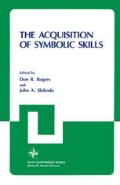Abstract
Children’s understanding of inclusion relations has been a topic of major theoretical concern in the study of cognitive development (see e.g. Inhelder and Piaget, 1964; Trabasso, Isen, Dolecki, McLanahan, Riley and Tucker, 1978; Winer, 1980). Inclusion relations describe the different levels of a hierarchical classification system? each successive level of the system is inclusive or superordinate to its subordinate levels. Children’s understanding of inclusion is assessed by asking them questions such as: “Are there more roses or flowers?”, where roses represent the subordinate and flowers the superordinate level of inclusion.
Access this chapter
Tax calculation will be finalised at checkout
Purchases are for personal use only
Preview
Unable to display preview. Download preview PDF.
References
Gibson, E. J., 1969, “Principles of perceptual learning and development”, Appleton-Century-Crofts, New York.
Gibson, E. J., 1982, The concept of affordances in development: The renascence of functionalism. In: W. A. Collins (Ed.), “Minnesota Symposia on Child Psychology, Vol. 15: The concept of development”. Lawrence Erlbaum, Hillsdale, N.J.
Gibson, E. J. and Spelke, E. S., in press, The development of perception and attention, In: J. Flavell & E. Markman (Eds.), “Carmichael’s manual of child psychology”, Wiley, New York.
Gibson, J. J., 1966, “The senses considered as perceptual systems”. Houghton Mifflin, Boston.
Gibson, J. J., 1977, The theory of affordances. In: R. Shaw & J. Bransford (Eds.), “Perceiving, acting and knowing”. Lawrence Erlbaum, Hillsdale, N.J.
Gibson, J. J., 1979, “The ecological approach to visual perception” Houghton Mifflin, Boston.
Hodkin, B., 1981, Language effects in assessment of class-inclusion ability. Child Development, 52, 470–478.
Inhelder, B. and Piaget, J., 1964, “The early growth of logic in the child: Classification and seriation”. Humanities Press, New York.
Jones, R. K. and Pick, A. D., 1981, Categorization and affordances. Behavioral and Brain Sciences, 4, 293–294.
McGarrigle, J., Grieve, R. and Hughes, M., 1978, Interpreting inclusion: A contribution to the study of the child’s cognitive and linguistic development. Journal of Experimental Child Psychology, 26, 528–550.
Mervis, C. B. and Rosch, E. H., 1981, Categorization of natural objects. Annual Review of Psychology, 32, 89–115.
Nelson, K., 1973, Some evidence for the cognitive primacy of categorization and its functional basis. Merill-Palmer Quarterly, 19, 21–39.
Nelson, K., 1979, Explorations in the development of a functional semantic system. In: W. A. Collins (Ed.), “Minnesota Symposia on Child Psychology”, Vol. 12. Lawrence Erlbaum, Hillsdale, N.J.
Smith, L. B. and Rizzo, T. A., 1982, Children’s understanding of the referential properties of collective and class nouns. Child Development, 53, 245–257.
Smitsman, A. W., 1981, A note on class inclusion. Internal Report 81 ON 02, Katholieke Universiteit Nijmegen, the Netherlands.
Trabasso, T., Isen, A. M., Dolecki, P., McLanahan, A. G., Riley, C. A., and Tucker, T., 1978, How do children solve class inclusion problems? In.: R. S. Siegler (Ed.), “Children’s thinking: What develops? Lawrence Erlbaum, Hillsdale, N.J.
Winer, G. A., 1980, Class inclusion reasoning in children: A review of the empirical literature. Child Development, 51, 309–328.
Author information
Authors and Affiliations
Editor information
Editors and Affiliations
Rights and permissions
Copyright information
© 1983 Plenum Press, New York
About this chapter
Cite this chapter
Smitsman, A.W., Pick, A.D. (1983). Perception of Inclusion in Collections of Objects. In: Rogers, D., Sloboda, J.A. (eds) The Acquisition of Symbolic Skills. Springer, Boston, MA. https://doi.org/10.1007/978-1-4613-3724-9_36
Download citation
DOI: https://doi.org/10.1007/978-1-4613-3724-9_36
Publisher Name: Springer, Boston, MA
Print ISBN: 978-1-4613-3726-3
Online ISBN: 978-1-4613-3724-9
eBook Packages: Springer Book Archive

